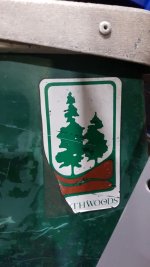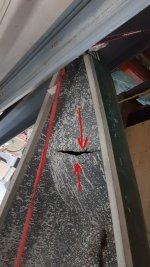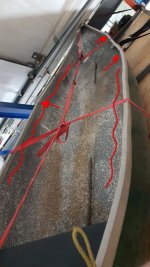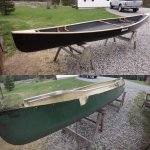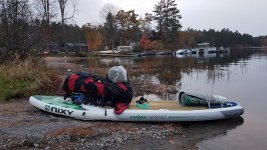Hello! I'm a complete newbie in some aspects, and here are a few of them: I recently moved to Canada (Ontario), fell in love with nature, and decided to celebrate my birthday at the end of October on an island in the Kawartha Lakes. I borrowed a paddle board from friends, packed my things in a huge backpack, and experienced the joys and challenges of paddling and portaging. After that, I understood that I need a canoe that can fit my wife, daughter, and our golden retriever. I bought a damaged canoe for repair almost for free because we don't have the money for a good canoe yet.
Please help me identify what kind of canoe I bought, whether it's worth dealing with, where to start with the repairs, and what should definitely be done after buying an old problematic canoe. My English is not as good, so reading forums quickly is a challenge for me, so I decided to ask you for advice. Also, I'm not familiar with the nuances of working with materials used for canoe repair. I'm a mechanic, used to working with metal objects, but here it's fiberglass, wood, varnishes, and paints... plus there are traditions and years of optimal solutions that I know nothing about. For example, I was very surprised when I saw in one of the discussions that someone simply bought a yoke on Amazon
In my canoe, the bow and stern floating parts are damaged, and one of the seats is missing. It's also likely that the attachments for the second seat are damaged. I decided that I would install new seats. Upon a quick inspection of the canoe hull, I didn't notice any cracks or other serious damage. Perhaps I didn't look for them well enough.
What materials would you recommend for the repair, what might I need? I'm not familiar with the brands available in stores, and your recommendations on choosing materials would be very helpful to me.
I'll also need to find and install a yoke and possibly another thwart for increased stiffness. But I'm not sure if it's worth complicating things and the canoe's structure with another thwart besides the yoke.
The gunwales are bent, it looks terribly messy. Is it worth trying to straighten the aluminum gunwales, or would it be easier to install new ones? If new ones, where can I even buy them? Also, I would like to repaint the canoe's sides outside and possibly inside. For this, the gunwales would have to be removed anyway. Is it worth buying new ones, or would it be easier to straighten and reinstall the old ones?
Thank you!!!
Please help me identify what kind of canoe I bought, whether it's worth dealing with, where to start with the repairs, and what should definitely be done after buying an old problematic canoe. My English is not as good, so reading forums quickly is a challenge for me, so I decided to ask you for advice. Also, I'm not familiar with the nuances of working with materials used for canoe repair. I'm a mechanic, used to working with metal objects, but here it's fiberglass, wood, varnishes, and paints... plus there are traditions and years of optimal solutions that I know nothing about. For example, I was very surprised when I saw in one of the discussions that someone simply bought a yoke on Amazon
In my canoe, the bow and stern floating parts are damaged, and one of the seats is missing. It's also likely that the attachments for the second seat are damaged. I decided that I would install new seats. Upon a quick inspection of the canoe hull, I didn't notice any cracks or other serious damage. Perhaps I didn't look for them well enough.
What materials would you recommend for the repair, what might I need? I'm not familiar with the brands available in stores, and your recommendations on choosing materials would be very helpful to me.
I'll also need to find and install a yoke and possibly another thwart for increased stiffness. But I'm not sure if it's worth complicating things and the canoe's structure with another thwart besides the yoke.
The gunwales are bent, it looks terribly messy. Is it worth trying to straighten the aluminum gunwales, or would it be easier to install new ones? If new ones, where can I even buy them? Also, I would like to repaint the canoe's sides outside and possibly inside. For this, the gunwales would have to be removed anyway. Is it worth buying new ones, or would it be easier to straighten and reinstall the old ones?
Thank you!!!


